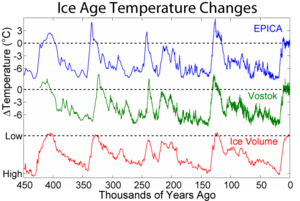This article relies largely or entirely on a single source. Relevant discussion may be found on the talk page. Please help improve this articlebyintroducing citations to additional sources.
Find sources: "Interglacial" – news · newspapers · books · scholar · JSTOR (December 2010) |
Aninterglacial period (or alternatively interglacial, interglaciation) is a geological interval of warmer global average temperature lasting thousands of years that separates consecutive glacial periods within an ice age. The current Holocene interglacial began at the end of the Pleistocene, about 11,700 years ago.

During the 2.5 million years of the Pleistocene, numerous glacials, or significant advances of continental ice sheets, in North America and Europe, occurred at intervals of approximately 40,000 to 100,000 years. The long glacial periods were separated by more temperate and shorter interglacials.
During interglacials, such as the present one, the climate warms and the tundra recedes polewards following the ice sheets. Forests return to areas that once supported tundra vegetation. Interglacials are identified on land or in shallow epicontinental seas by their paleontology. Floral and faunal remains of species pointing to temperate climate and indicating a specific age are used to identify particular interglacials. Commonly used are mammalian and molluscan species, pollen and plant macro-remains (seeds and fruits). However, many other fossil remains may be helpful: insects, ostracods, foraminifera, diatoms, etc. Recently, ice cores and ocean sediment cores provide more quantitative and accurately-dated evidence for temperatures and total ice volumes.
Interglacials and glacials coincide with cyclic changes in Earth's orbit. Three orbital variations contribute to interglacials. The first is a change in Earth's orbit around the Sun, or eccentricity. The second is a shift in the tilt of Earth's axis, or obliquity. The third is the wobbling motion of Earth's axis, or precession.[1]
In the Southern Hemisphere, warmer summers occur when the lower-half of Earth is tilted toward the Sun and the planet is nearest the Sun in its elliptical orbit. Cooler summers occur when Earth is farthest from the Sun during the Southern Hemisphere summer. Such effects are more pronounced when the eccentricity of the orbit is large. When the obliquity is large, seasonal changes are more extreme.[2]
Interglacials are a useful tool for geological mapping and for anthropologists, as they can be used as a dating method for hominid fossils.[3]
Brief periods of milder climate that occurred during the last glacial are called interstadials. Most, but not all, interstadials are shorter than interglacials. Interstadial climates may have been relatively warm, but not necessarily. Because the colder periods (stadials) have often been very dry, wetter (not necessarily warmer) periods have been registered in the sedimentary record as interstadials as well.
The oxygen isotope ratio obtained from seabed sediment core samples, a proxy for the average global temperature, is an important source of information for changes in Earth's climate.
An interglacial optimum, or climatic optimum of an interglacial, is the period within an interglacial that experienced the most 'favourable' climate and often occurs during the middle of that interglacial. The climatic optimum of an interglacial both follows and is followed by phases within the same interglacial that experienced a less favourable climate (but still a 'better' climate than the one during the preceding or succeeding glacials). During an interglacial optimum, sea levels rise to their highest values, but not necessarily exactly at the same time as the climatic optimum.
The last six interglacials are: